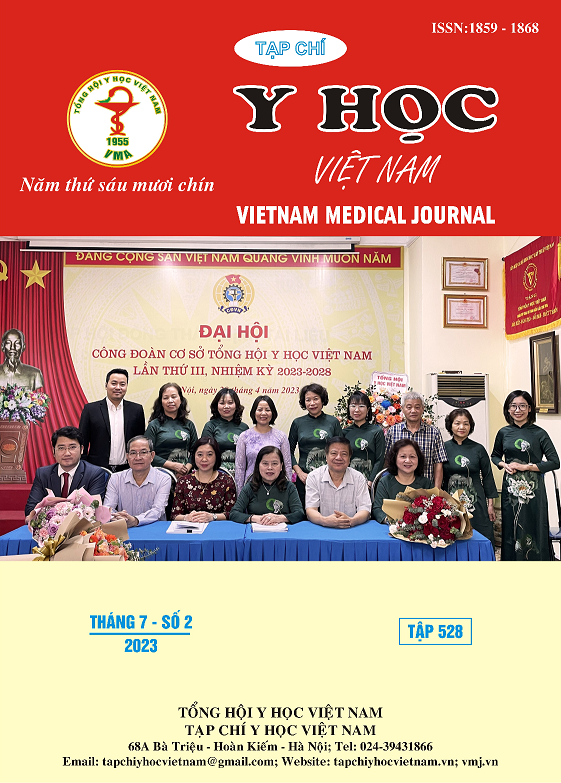ASSESS THE LOCATION OF THE SPHENOID SINUS OSTIUM IN RELATION TO THE PNEUMATIZATION OF THE SPHENOID SINUS AND SOME ADJACENT STRUCTURES ON COMPUTED TOMOGRAPHY
Main Article Content
Abstract
Background: The sphenoid ostium (SO) is one of the most important anatomical landmarks for the sinus and skull base surgery. Hence, the comprehensive understanding of the position and characteristics of the SO with respect to the anterior sphenoid face is crucial. There are abundant studies evaluating the impact of the sphenoid pneumatization with the surrounding structures, however, the literature lacks reports on the relationship of the sphenoid pneumatization and some adjacent structures with the location of the ostium. Objective: The aim of this study was to assess the location of the sphenoid sinus ostium in relation to the pneumatization of the sphenoid sinus, sphenoid rostrum and Onodi cell on CT scan. Materials and Methods: This is a cross-section study in which we reviewed computed tomography images of paranasal sinuses in 181 patients (362 sphenoid sinuses) who have been treated as in-patients and outpatients at ENT hospital in Ho Chi Minh City. Results: Onodi cells were identified in 39% of cases. The sphenoid rostrum pneumatization, which were more common, were found in about 53% of cases. On sagittal sections, the presellar, sellar, and postsellar sphenoid pneumatization were found in 6,4%, 40,9%, and 52,8% of cases, respectively. The type of pneumatization on the coronal plane was found to be type 1 (previdian) in 19,3% sides, type 2 (intercanal) in 30,1% sides, and type 3 (postrotundum) in 50,6%. The presence of Onodi cells had a significant effect on the location of the SO on sagittal plane. In addition, both rostrum pneumatization and sphenoid sinus pneumatization also related to the position of the SO on vertical plane. Conclusion: In our study, we demonstrated that the pneumatization of sphenoid sinus and some adjacent structures such as the sphenoid rostrum, and Onodi cells have a relationship with the location of the SO. The appreciation of the pneumatization variants on preoperative CT scans will help the surgeons to navigate the orientation of SO during the surgery and improve the surgical outcomes for our patients.
Article Details
Keywords
sphenoid ostium, Onodi cell, sphenoid rostrum, sphenoid pneumatization
References
2. Doubi A, Albathi A, Sukyte-Raube D, Castelnuovo P, Alfawwaz F, AlQahtani A. Location of the Sphenoid Sinus Ostium in Relation to Adjacent Anatomical Landmarks. Ear Nose Throat J. Jun 8 2020:145561320927907. doi:10.1177/0145561320927907
3. Göçmez C, Göya C, Hamidi C, Teke M, Hattapoğlu S, Kamaşak K. Evaluation of the surgical anatomy of sphenoid ostium with 3D computed tomography. Surgical and Radiologic Anatomy. 2014;36(8):783-788.
4. Gupta T, Aggarwal A, Sahni D. Anatomical landmarks for locating the sphenoid ostium during endoscopic endonasal approach: a cadaveric study. Surgical and radiologic anatomy. 2013;35(2):137-142.
5. Halawi AM, Simon PE, Lidder AK, Chandra RK. The relationship of the natural sphenoid ostium to the skull base. Laryngoscope. Jan 2015;125(1):75-9. doi:10.1002/lary.24393
6. Jaworek-Troć J, Walocha J, Skrzat J, et al. A computed tomography comprehensive evaluation of the ostium of the sphenoid sinus and its clinical significance. Folia Morphologica. 2022;81(3):694-700.
7. Kaplanoglu H, Kaplanoglu V, Toprak U, Hekimoglu B. Surgical measurement of the sphenoid sinus on sagittal reformatted CT in the Turkish population. The Eurasian Journal of Medicine. 2013;45(1):7.
8. Twigg V, Carr SD, Balakumar R, Sinha S, Mirza S. Radiological features for the approach in trans-sphenoidal pituitary surgery. Pituitary. 2017;20:395-402.
9. Wada K, Moriyama H, Edamatsu H, et al. Identification of Onodi cell and new classification of sphenoid sinus for endoscopic sinus surgery. Wiley Online Library; 2015:1068-1076.


